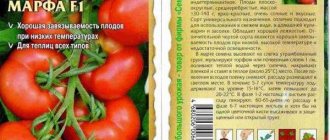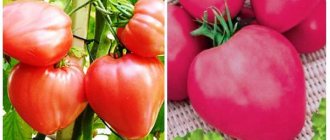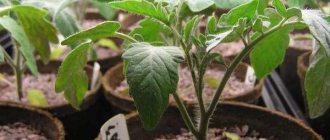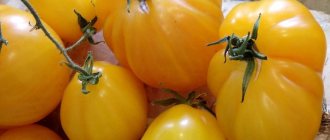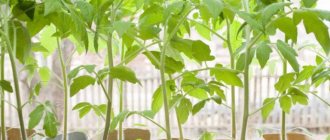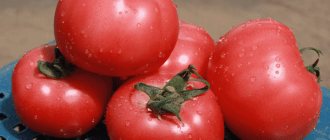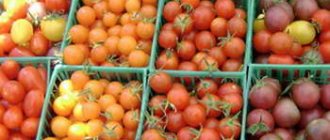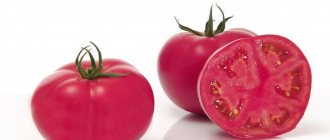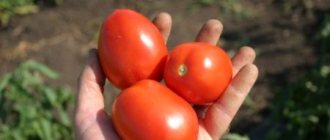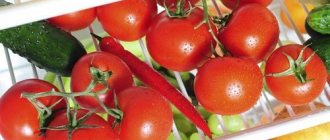Dutch selection never ceases to delight gardeners around the world. One of the best new products was the Magnus F1 tomato. The first generation hybrid is equipped with high productivity, excellent taste, endurance to weather stress and resistance to many diseases. This makes him a welcome guest in the garden.
| Height | Landing location | Ripening time | Fruit color | Fruit size | Origin | Fruit shape |
| Medium height | Greenhouse, Open ground | Early ripening | Reds | Average | Hybrid | Flat-round |
Characteristics of tomatoes
Magnus is a promising and high-yielding hybrid of the first generation, bred by Dutch breeders. The tomato combines early ripening with good yield and high taste of the fruit. Typically, tomatoes with a short growing season do not have very high consumer qualities, but this variety is a clear exception to the rule. Ripe tomatoes are distinguished by their attractive appearance, delicate but bright aroma, balanced taste without wateriness and herbal notes. All these advantages make the plant an ideal option for growing in personal backyards and on small farms.
The hybrid is zoned for the Central region of Russia, but can be grown in any area. Plants feel best in film, polycarbonate or glazed greenhouses. The shortened growing season makes it possible to plant tomatoes in mid-spring; the harvest can be harvested in the first half of summer.
In regions with a warm climate, you can try to grow seedlings in open beds, but in this case the yield is slightly reduced.
Magnus is a promising and high-yielding hybrid of the first generation, bred by Dutch breeders.
Magnus is distinguished by good resistance to diseases and pests. The hybrid is rarely affected by cladosporiosis, verticillium, and root-knot nematodes. Cases of virus infection are rare. Early ripening protects seedlings from late blight of fruits and leaves.
II. Indeterminate varieties (unlimited growth)
These are tomatoes that will grow until they turn blue until the owner or the onset of the cold season stops them. They have great yield potential, which is more successfully realized in high greenhouses. We place approximately three bushes on 1 square. With supports such as strong trellises, open ground is not prohibited, which will be especially welcome in the southern regions.
Tomato Scarlet candles
Good for pickling, sweet. This is a patented mid-early variety (Siberian breeders distinguished themselves!). In the state register since 2007. They are characterized by a high ability to form ovaries in any conditions. From 1 sq.m you can actually get a bucket and a half. The clusters are arranged in tiers, the weight of the fruit on the lower branches reaches 120 g, on the top ones - half as much.
Very lightweight. A mid-early Siberian variety for canning whole vegetables. The fruits are elongated, reaching (maximum in our conditions) 13-14 cm in length, weighing about 120 g, and have a beautiful crimson hue. They have few seeds, are very fleshy, strong, and easy to keep. If they are picked green, they do not spoil and ripen perfectly. The variety is very responsive to high-quality fertilizing.
We invite you to read: Champignons are grown on human feces
The longest
A new product of Siberian selection. It begins to ripen already on the 110th (you can add a couple more) days from the sprouts appearing on the surface of the soil. Fruits have a unique length - 20 cm (specific size)! They are very elongated, with a small pear-shaped constriction in the upper part, uniformly slightly expanding downwards, with a spout.
High yield
The variety is productive and unpretentious. Tolerates slight shading. It ties well. Neither high nor low temperatures are scary. It succeeds in protected soil, but outdoor cultivation is not prohibited. Tomatoes begin to ripen in 106-113 days; at the same time, the plant successfully continues to grow and form clusters - up to 10 pieces per bush.
Each bears up to eight graceful fruits - cylindrical and pointed, in full ripeness - iridescent pink in color. The weight of each vegetable is 100-120 g. They contain a high percentage of sugars and dry matter. They do not burst when pickled, are good for drying, obtaining thick juice and, oddly enough in your opinion, for making tomato jam. With diligent care, the bush can bear up to a bucket of quality fruit.
Tomato Niagara
Weighty brushes
This mid-early vegetable variety has been on the state register since 2010. The bush is tall, but compact in width. It has a highly branched root system, responsive to increased nutrition and good water supply. A valuable feature of this Siberian variety is its multiple clusters, each of which bears up to 14 fruits weighing 85-115 g.
Meaty and sweet
This is one of the sweetest and meatiest products of Siberian breeders. It has been registered in the state register since 2007. The tomato is mid-season (116-118 days from the appearance of sprouts), with large foliage. The fruits resemble long, sharp peppers - they grow up to 15 cm. They are an elegant red color, the weight ranges from 120-185 g. The pulp of vegetables contains very little water and seeds. In the best case, there are up to a dozen fruits in one cluster. One bush gives 2-3 kg.
Tomato Koenigsberg
Excellent ovary
Included in the state register in 2005. The variety rightfully takes its place among the most productive Siberian varieties (up to 20 kg per square meter of land in a greenhouse). It sets perfectly even in the hot atmosphere of closed ground. Plants with a powerful bush with large leaves require increased nutrition and careful pinching.
The first ovary is formed after the growth of the 12th leaf, then inflorescences are formed every 3 leaves. Refers to varieties of medium ripening; in Siberian conditions, approximately half of the crop ripens; the rest of the fruits turn red quite well when ripened. Tomatoes in the lower clusters of vegetables weigh 300 g, and in those above - no less than 150 g. The shape is elongated, heart-shaped, smooth, and beautiful.
Vitamin and sweet
Ripe tomatoes have a golden-orange color and contain a record amount of carotene vitamins. The pulp is sweet and aromatic, like berries and fruits. The ripening period is average. The lower fruits are capable of filling up to a mass of 400-450 g, higher up the bush - 200-300 g. They are oval, often with a spout. The plants grow clusters through the leaves, each containing on average, as stated, up to 5 fruits. Productivity is high. The keeping quality is excellent. It is especially tasty when salted with gelatin.
Harvest hearts
Close internodes and a powerful trunk with dense foliage are like standard varieties, only the height is two meters. The Siberian breeding novelty produces half a bucket of fruit from one such “tree”. Ripening begins on the 115th day. Forms up to 6 beautiful clusters with 5-7 red tomatoes weighing 200-250 grams, shaped like strawberries.
Tomato Budenovka
Resistant to cracking
The variety is an improved version of Ox Heart, with a higher yield (about 9.4 kg per square), early ripening, good resistance to diseases (even to late blight) and cracking of the apical tissue of the fruit for a fleshy variety. Heart-shaped, ribbed tomatoes with excellent taste.
Record weight
The variety is a new product from a team of breeding scientists under the leadership of V.F. Gavrisha. Registered in the state register in 2015. Due to the unrealistically large fruits of vegetables, it is included in the “Russian Hero” series. The variety is not very fast in terms of ripening time (from 120 days), therefore it requires early planting of seedlings, especially careful pinching and decent feeding.
In Siberia and Central Russia it works well only in closed ground conditions, including a greenhouse. The average return from a bush is 3.6 (plus or minus) kg, the record is 7 kg. The tomatoes are flat-round, slightly ribbed, have an excellent smell and are very juicy, each weighing 400-600 g, not uncommon - 800 g. There are 2-3 tomatoes in one cluster of plants; if you leave only one tomato in it, it can pull more than 1 kg. Such “bogatyrs” are better suited for salads and distillation for juice.
Bowl of salad from one fruit
One of the best salad novelties, the yield is high. The plant bears 5-6 racemes. The fruits look very attractive due to their raspberry-pink color, large up to 500-800 g. The tomatoes are flat-round, ribbed, sweet. There is high resistance to cracking; The pulp density is average. A rare quality for large-fruited varieties: the fruits do not tend to quickly soften and spoil during storage.
According to the ripening period, the variety is classified as mid-early and mid-ripe. Perfect for preparing preparations: tomato paste, juice. This tomato variety is characterized by high yield. You can remove up to 5-6 kilograms of tomatoes from one bush.
Giant orange sweet
It has plasticity, rare for a large-fruited variety, and relative unpretentiousness. Delicate sweet pulp combines with excellent keeping quality. The tomatoes are round-flat (their “ribs” stand out a little), sunny orange in color. The average weight of a tomato is 0.5 kg, but in reality there are 1 kg of fruit on the bush.
Gallery: tomato Magnus (25 photos)
Description of the plant
The hybrid is an early ripening hybrid; 95 days pass from the emergence of seedlings to the harvesting of the first fruits . The bush is semi-determinate, moderately spreading, the formation of green mass is average. The leaves are large, dark green, the stems are strong, juicy, and not prone to brittleness. Light shaping is necessary with the removal of excess shoots, but heavy pruning will not benefit the plant. The inflorescence is simple. The tomatoes ripen in beautiful small clusters of 4-6 pieces; at the moment of active fruiting, the bush looks very decorative. Fruits can be picked in clusters or individually, in a state of physical or technical ripeness.
Also read: Characteristics and description of the Pink Flamingo tomato variety
The tomatoes are flat-rounded, with pronounced ribbing at the stalk. The color is deep red, without spots or stripes. The skin is thin, but quite dense and glossy. The fruits are smooth, medium-sized, but very beautiful. The average weight ranges from 140 to 160 g. In appearance, Magnus resembles a Matias F1 or Eigen F1 tomato, but the latter is more impressive in size (average fruit weight is from 180 to 200 g). The pulp is juicy, has few seeds, and the chambers are small.
Such tomatoes can be used for whole-fruit canning or included in assorted vegetables. The rich, bright taste makes tomatoes suitable for making soups, sauces, purees for baby food, and bright red thick juices.
Magnus is best propagated by seedlings.
The hybrid has excellent taste. The pulp contains a lot of sugars, solids, lycopene, vitamin C and amino acids. The tomatoes are aromatic, sweetish, with light fruity notes. Close analogues in taste are tomato Schastie Russkoe F1, Berberana, Belfort, Gilgal, Eigen F1, Mondial, Sovereign. Gardeners who have already tried these hybrids will certainly like Magnus.
Its big advantage is its early ripening. The listed plants begin to bear fruit 10-15 days later. Another interesting analogue is the pink-fruited tomato Lily Marlene F1, which is often grown in the same greenhouse with Magnus due to similar agrotechnical requirements.
Description and characteristics of the variety
Tomato Magnus F1 is a semi-determinate, medium-sized hybrid with shoot vigor comparable to indeterminate varieties. Its bushes are characterized by the following signs:
- stem height is within 1-1.2 m;
- compactness;
- moderate foliage;
- fruits per 1 bunch 4-6;
- inflorescence simple;
- the number of fruiting clusters is 7-8.
- average weight 150 g;
- elasticity of the fleshy pulp;
- non-cracking skin;
- transportability and keeping quality;
- moderate ribbing;
- the shape is flattened and round.
Tomatoes are used for salads and winter preparations. They are used to prepare flavorful juices and ketchups.
Advantages and disadvantages
The advantages of the Magnus F1 hybrid include:
- high productivity;
- early amicable maturation;
- excellent taste of ripe tomatoes;
- low maintenance requirements;
- resistance to cladosporiosis, verticillium, root-knot nematode;
- the ability to grow in any shelter - from ordinary greenhouses to heated greenhouses;
- versatility of fruits;
- availability of seed material.
Experienced gardeners highly appreciate the consumer qualities of the hybrid. Magnus F1 cannot be classified as a new product; it has been successfully grown for several years. Reviews from professionals and amateurs note stable yields, good taste of ripe tomatoes, and resistance to pests and diseases. A close analogue is the Indio F1 tomato; these plants can be grown in the same greenhouse.
Magnus tomatoes have few disadvantages. They are picky about the composition of the soil and love generous fertilizing and proper watering. Under favorable conditions, productivity increases significantly. In the first generation, hybrids can produce seeds, but the resulting seedlings do not carry the qualities of the mother plants.
Subtleties of cultivation
Magnus is best propagated by seedlings . When planted directly in the ground, tomato seeds will germinate too late, which will significantly reduce the yield. Depending on the region, sowing begins in late February or early March. Picking can slow down the growth of seedlings. Young tomatoes must be fed with liquid complex fertilizer, since the hybrid prefers nutritious soil.
Also read: Why do tomato leaves dry out: the main reasons
Magnus tomatoes have few disadvantages. They are picky about the soil composition and love generous fertilizing and proper watering.
The seedlings are moved to the shelter in early or mid-May. A good neighbor in the greenhouse will be the Bagheera F1 tomato, which is also an early ripening tomato. The plants are tied to supports, and the lower leaves are removed for better insolation. It is possible to form 2-3 stems, the remaining stepsons should be removed. Gardeners who want to extend the harvest period can supplement Magnus with the later Belle F1 tomato. The tomato duet will allow you to harvest until the end of summer.
A promising hybrid of Dutch selection suitable for most subsidiary plots. By planting Magnus in a greenhouse or in garden beds, you can count on a decent harvest and wonderful taste of ripe tomatoes.
Features of care
Caring for the Magnus hybrid involves tying the bushes to supports. It is necessary to immediately install long sticks or poles so that you do not have to extend them later.
Tie the stem carefully, without damaging it or pinching the brushes and leaves. Leave a small gap.
Magnus tomatoes are tied for the first time when they reach a height of 40-50 cm under the first fruiting cluster.
To obtain optimal yield results, form a bush with 2-3 stems. When the plant reaches a critical size and has formed a sufficient number of fruiting clusters, trim the top to stop growth.
On subsequent clusters, the ovaries will not have time to properly form and ripen, but will only delay the ripening processes of existing fruits. Throughout the season, remove shoots and excess leaves as they wilt.
Removing the lower leaves promotes the flow of substances to flowers and ovaries, preventing the possibility of plant infections. The leaves are pruned after the fruits on the lower cluster begin to ripen.
Magnus tomatoes need abundant, regular, but infrequent watering. Once every 5-7 days is enough, as the top layer of soil dries.
Water the bushes at the roots only with warm water. It is better to water in the early morning or late evening.
Early morning is the ideal time for many procedures. Removing leaves and shoots in the early morning allows the plant to have time to heal the wounds, which will not become sources of possible infection.
Be sure to regularly weed and loosen the soil. Removing weeds improves the ventilation of bushes and prevents plants from being damaged by diseases and pests. Loosening improves gas exchange and enriches the soil with oxygen.
Hilling helps tall tomatoes to form a developed root system and ensure an influx of nutrients. Hilling is carried out with the appearance of small nodules at the bottom of the stem. The second time is when the color of the stem changes to dark blue.
Mulching prevents rapid drying of the soil, the formation of a hard earthen crust, erosion of the soil during watering and exposure of roots. Rotted sawdust, hay, straw, pine needles or dark non-woven material are used.
Periodic light shaking of the flowering clusters helps to increase the percentage of ovary formation.
This makes pollination more efficient. In open ground, tomatoes are helped by wind and insects. In greenhouses and greenhouses their influence is noticeably reduced. It is enough to shake once every few days.
It is imperative to ventilate greenhouses. This helps regulate humidity levels and prevents fungal diseases from affecting plants.

